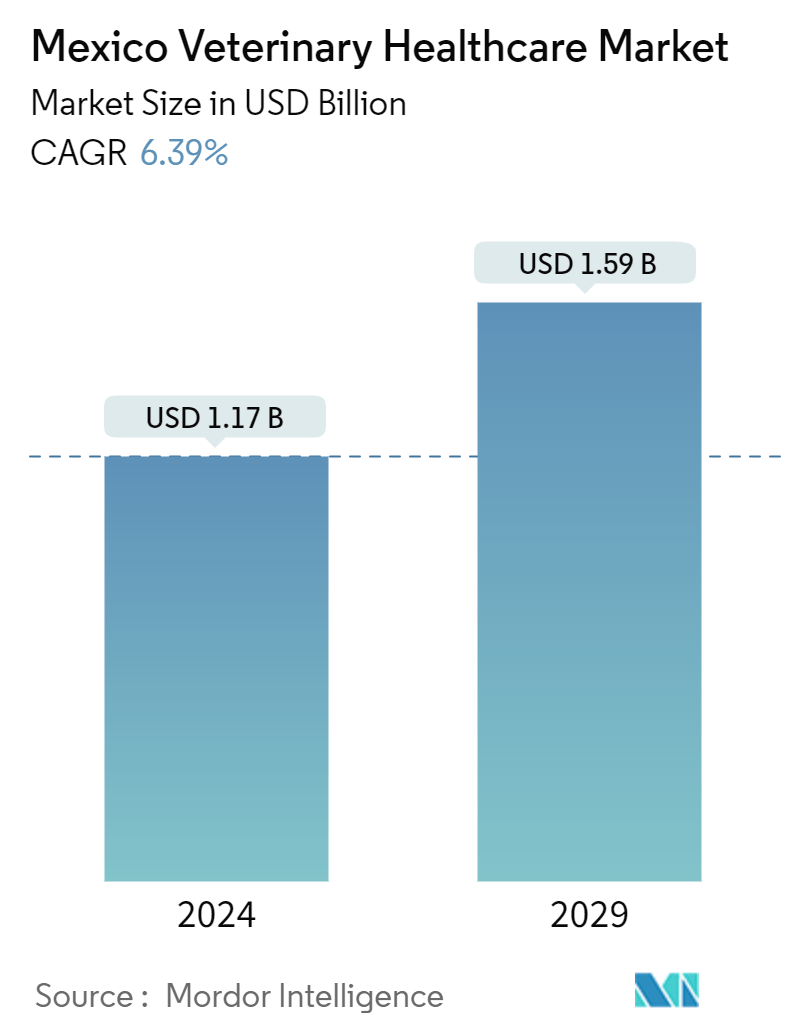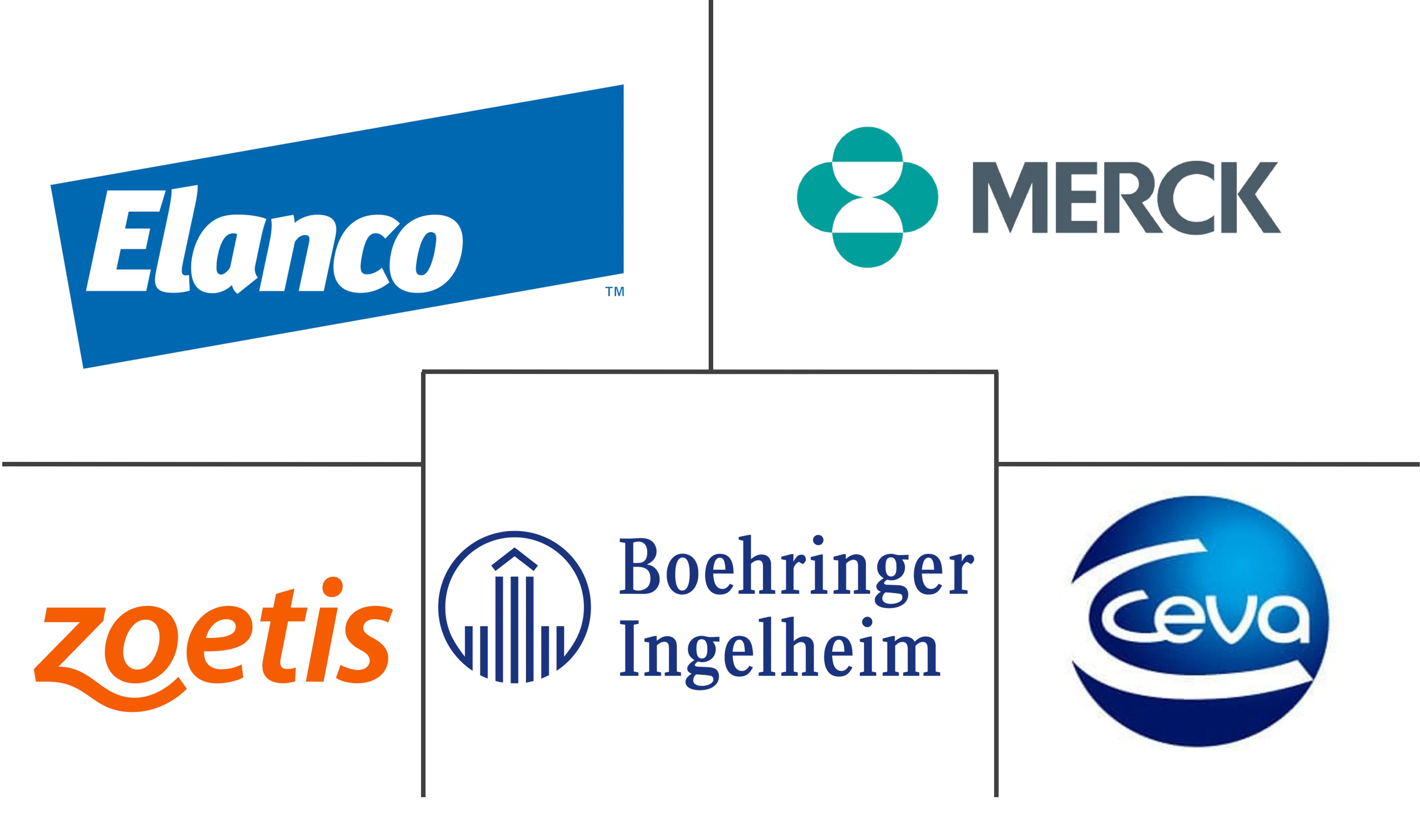Market Size of Mexico Veterinary Healthcare Industry

| Study Period | 2019 - 2029 |
| Base Year For Estimation | 2023 |
| Market Size (2024) | USD 1.17 Billion |
| Market Size (2029) | USD 1.59 Billion |
| CAGR (2024 - 2029) | 6.39 % |
| Market Concentration | High |
Major Players
*Disclaimer: Major Players sorted in no particular order |
Mexico Veterinary Healthcare Market Analysis
The Mexico Veterinary Healthcare Market size is estimated at USD 1.17 billion in 2024, and is expected to reach USD 1.59 billion by 2029, at a CAGR of 6.39% during the forecast period (2024-2029).
The Mexico Veterinary Healthcare market is experiencing significant growth, driven by fundamental megatrends that are reshaping the industry landscape. The increasing pet adoption rates, growing awareness of animal health, and the rising importance of food safety in livestock production are key factors propelling the market forward. These overarching trends are closely intertwined with the specific drivers of advanced technologies and the focus on productivity, which are playing crucial roles in transforming animal healthcare practices across Mexico.
Advanced Technologies Leading to Innovations in Animal Healthcare: The integration of cutting-edge technologies is revolutionizing veterinary healthcare in Mexico. This trend is characterized by the development of innovative diagnostic tools, treatment methods, and preventive care solutions. The presence of key industry players is accelerating the availability of technologically advanced veterinary products in the country. Notable initiatives include the launch of new vaccination projects, such as the United States-Mexico partnership to evaluate a new bovine tuberculosis vaccine. Furthermore, the digitization of animal healthcare services is gaining momentum, with companies like Folio3 Software Inc. introducing mobile-based solutions for farmers, ranchers, and animal care specialists. These technological advancements are not only improving the quality of care but also making veterinary services more accessible and efficient across Mexico.
Increasing Productivity at the Risk of Emerging Zoonosis: The drive for increased productivity in animal husbandry is a double-edged sword, bringing both opportunities and challenges to Mexico's veterinary healthcare sector. On one hand, efforts to boost livestock productivity are leading to advancements in animal nutrition, breeding techniques, and disease management. However, this push for higher yields is also raising concerns about the potential emergence and spread of zoonotic diseases. The World Health Organization reported over 200 prevailing zoonosis diseases worldwide, highlighting the critical need for vigilant healthcare practices. In response, Mexico is taking proactive measures, such as implementing virtual training programs for veterinarians to address serious animal diseases. The Ministry of Agriculture and Rural Development trained more than 2,000 veterinarians across Mexico, focusing on various diseases and their treatments. Additionally, initiatives like the WEAN UP program demonstrate a holistic approach to animal health management, particularly in the swine industry.
Mexico Veterinary Healthcare Industry Segmentation
As per the scope of the report, the Mexican veterinary healthcare market comprises therapeutic and diagnostics products and solutions for companion and farm animals. Companion animals can be tamed or adopted for companionship or as house/office guards, while farm animals are raised for meat and milk-related products. Companion animals include canine, feline, and equine. Farm animals include bovine, poultry, and porcine.
The Mexican veterinary healthcare market is segmented by product and animal type. By product, the market is segmented into therapeutics and diagnostics. By therapeutics, the market is segmented into vaccines, parasiticides, anti-infectives, medical feed additives, and other therapeutics. By diagnostics, the market is segmented into immunodiagnostic tests, molecular diagnostics, diagnostic imaging, clinical chemistry, and other diagnostics. By animal type, the market is segmented into dogs, cats, horses, ruminants, swine, poultry, and other animals. The report offers the value in USD for these segments.
| By Product | |||||||
| |||||||
|
| By Animal Type | |
| Dogs and Cats | |
| Horses | |
| Ruminants | |
| Swine | |
| Poultry | |
| Other Animals |
Mexico Veterinary Healthcare Market Size Summary
The Mexican veterinary healthcare market is poised for significant growth over the forecast period, driven by advancements in technology and increasing awareness of zoonotic diseases. The market is recovering from the disruptions caused by the COVID-19 pandemic, which had led to increased costs and supply chain challenges. As restrictions ease, the demand for veterinary services is expected to rise, supported by government initiatives and health promotion programs aimed at controlling zoonotic diseases. The implementation of the One Health approach and specific action programs for disease prevention are creating opportunities for companion healthcare products, further propelling market expansion. Technological innovations, such as smart wearable devices and AI applications in animal health, are also contributing to the market's growth by enhancing disease monitoring and prevention capabilities.
Despite challenges like rising healthcare costs and the prevalence of counterfeit medicines, the market is expected to benefit from the increasing prevalence of zoonotic diseases, which is driving demand for vaccines and other veterinary healthcare products. The market is characterized by the presence of major players such as Zoetis Animal Healthcare, Merck Animal Health, and Bayer Animal Health, among others, who are actively launching new products and expanding their presence in the region. The introduction of advanced vaccines and the establishment of new facilities by companies like Kemin Industries are expected to further strengthen the market. Overall, the Mexican veterinary healthcare market is set to experience robust growth, supported by technological advancements, government initiatives, and a growing focus on disease prevention and control.
Mexico Veterinary Healthcare Market Size - Table of Contents
-
1. MARKET DYNAMICS
-
1.1 Market Overview
-
1.1.1 Advanced Technologies Leading to Innovations in Animal Healthcare
-
1.1.2 Increasing Productivity at the Risk of Emerging Zoonosis
-
-
1.2 Market Restraints
-
1.2.1 Increasing Cost of Animal Testing and Veterinary Services
-
1.2.2 Scarcity of Arable Land and Water
-
1.2.3 Use of Counterfeit Medicines
-
-
1.3 Industry Attractiveness - Porter's Five Forces Analysis
-
1.3.1 Threat of New Entrants
-
1.3.2 Bargaining Power of Buyers/Consumers
-
1.3.3 Bargaining Power of Suppliers
-
1.3.4 Threat of Substitute Products
-
1.3.5 Intensity of Competitive Rivalry
-
-
-
2. MARKET SEGMENTATION (Market Size by Value – USD)
-
2.1 By Product
-
2.1.1 Therapeutics
-
2.1.1.1 Vaccines
-
2.1.1.2 Parasiticides
-
2.1.1.3 Anti-infectives
-
2.1.1.4 Medical Feed Additives
-
2.1.1.5 Other Therapeutics
-
-
2.1.2 Diagnostics
-
2.1.2.1 Immunodiagnostic Tests
-
2.1.2.2 Molecular Diagnostics
-
2.1.2.3 Diagnostic Imaging
-
2.1.2.4 Clinical Chemistry
-
2.1.2.5 Other Diagnostics
-
-
-
2.2 By Animal Type
-
2.2.1 Dogs and Cats
-
2.2.2 Horses
-
2.2.3 Ruminants
-
2.2.4 Swine
-
2.2.5 Poultry
-
2.2.6 Other Animals
-
-
Mexico Veterinary Healthcare Market Size FAQs
How big is the Mexico Veterinary Healthcare Market?
The Mexico Veterinary Healthcare Market size is expected to reach USD 1.17 billion in 2024 and grow at a CAGR of 6.39% to reach USD 1.59 billion by 2029.
What is the current Mexico Veterinary Healthcare Market size?
In 2024, the Mexico Veterinary Healthcare Market size is expected to reach USD 1.17 billion.

